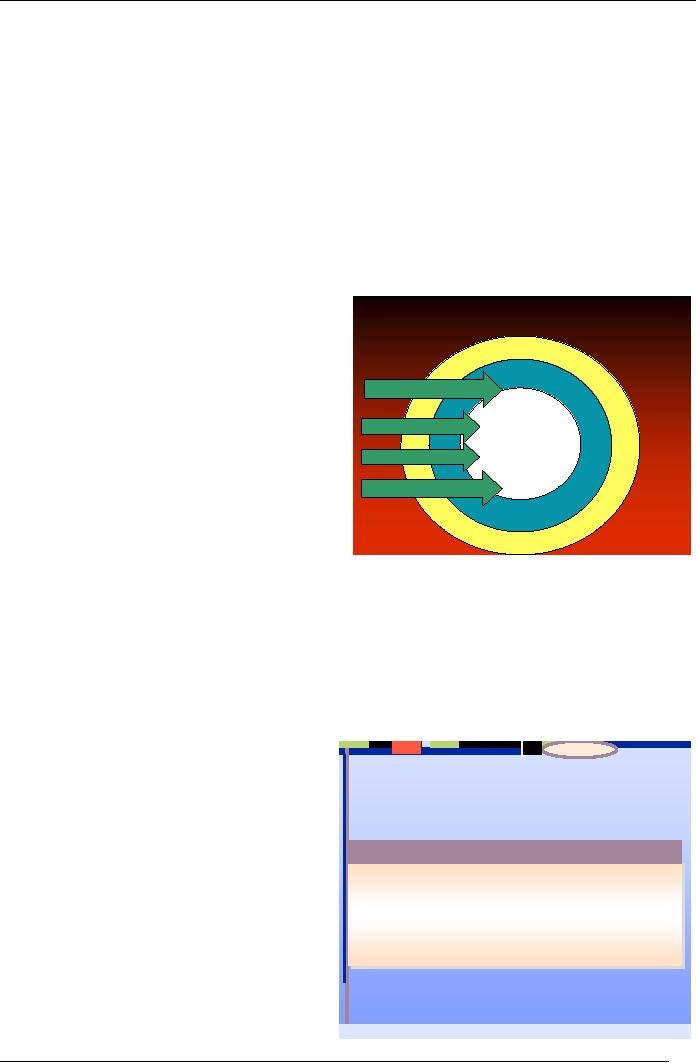 |

Human
Resource Management
(MGT501)
VU
Lesson
38
EMPLOYEE
RIGHTS AND DISCIPLINE
After
studying this chapter, students should be
able to understand the
following:
A.
Employee Rights
B.
Disciplining Employees
LESSON
OVERVIEW
Today's
lecture examines employee rights
and employee discipline. The
concepts of employee rights,
management
rights, and the employment-at-will
doctrine are discussed.
Some challenges
managers
encounter
in balancing employee rights with
their own rights and responsibilities
(duties) are explored.
Employee
discipline is discussed, and some
suggestions for managing
difficult employees are
offered.
A.
Employee Rights
Employee
rights allow them to engage in
conduct
protected
by laws and social
sanctions. Federal
and
state
governments have enacted
laws giving
Discrimination
law
employees
specific protection in their
relationship
with
their employer. The courts
have also been
Minimum
wage
Employment
willing
to protect workers from
wrongful discharge.
at
These
rights include statutory, contractual, and
other
Labor
law
Will
rights.
Rights
to privacy
B.
Employee Rights
There
are many laws and
regulations governing
human
resource management that
have been created
to
help define, maintain, and preserve
employee
rights.
Discrimination laws essentially give
people the right to work without being
evaluated on the basis of
non-job-relevant
factors such as religion, origins,
sex or race. Minimum wage
legislation gives people the
right
to expect a certain base level of
compensation for their work.
Labor laws give employees the
right to
organize
and join a labor union under
certain prescribed circumstances.
Employee rights allow them to
engage
in conduct protected by laws and social
sanctions. Federal and state
governments have enacted
laws
giving
employees specific protection in
their relationship with their employer.
The courts have also
been
willing
to protect workers from
wrongful discharge. These rights include
statutory, contractual, and
other
rights.
a)
Statutory Rights
The
key statutory rights can be found in
laws such
in
Civil Rights Acts, the Occupational
Safety and
Categories
of Employee Rights
Health
Act (OSHA), and the National
Labor
Relations
Act (NLRA). These rights
Protect
employees
from discrimination, Safe
working
conditions,
Right to form unions
Statutory
Rights
Contractual
Rights
Other
Rights
b)
Contractual Rights
�
Protection
from
�
Employment
contract
�
Ethical
treatment
A
written employment contract details the
terms
discrimination
�
Union
contract
�
Privacy
(limited)
�
Safe
working
�
Implied
contracts/
�
Free
speech
of
the employment relationship. These
contracts
conditions
employment
policies
(limited)
usually
address such issues as
seniority, due
�
Right to
form
unions
process,
and wrongful discharge.
Besides written
contracts,
there are implied contracts.
Employee
handbooks,
employment policies, and
statements
made
by an interviewer or manager may
be
interpreted
by the courts as implied
contracts.
171

Human
Resource Management
(MGT501)
VU
c)
Other Rights
Beyond
statutory and contract rights, employees
may have rights to ethical
treatment, limited free
speech,
and
limited privacy.
d)
Ways Managers and Supervisors
Can Influence Their Companies' Climate
of
Fairness
and Behavior
Take
actions that develop trust, such as
sharing useful information
and making good on
commitments.
Act
consistently so that employees
are not surprised by
unexpected management actions
or
decision.
Be
truthful and avoid white
lies and actions designed to
manipulate others by giving a certain
(false)
impression.
Demonstrate
integrity by keeping confidences and
showing concern for
others.
Meet
with employees to discuss
and define what is expected of
them.
Ensure
that employees are treated
equitably, giving equivalent rewards
for similar performance
and
avoiding
actual or apparent special treatment of
favorites.
Adhere
to clear standards that are
seen as just and
reasonable.
Demonstrate
respect toward employees,
showing openly that they
care about employees
and
recognize
their strengths and
contributions.
e)
Management Rights
Management
rights are the rights to run the business
and to retain any profits
generated. In particular, this
includes
the right to direct the work force (i.e.,
to hire employees and set
pay levels). Often, these
rights are
residual.
Residual rights are those remaining
that are not affected by
contracts or other (i.e.,
EEO) laws.
f)
Employment at Will
It
is a common law doctrine stating
that employers have the
right to hire, fire, demote, or
promote
whomever
they choose, unless there is a
law or contract to the contrary and
Employees have the right
to
quit
and got another job under the
same constraints. The
employment-at-will rule was adopted in
the
nineteenth
century. Workers were free to terminate
their relationship (employment) for any
reason, so the
courts
deemed it fair for employers
to be able to do the same. Such a rule
has stacked the deck in
favor of
the
employer, giving wrongfully discharged
employees little legal
recourse. Nevertheless,
employment-at-
will
is limited in certain situations.
These include cases of public
policy exceptions, implied
contracts, and
lack
of good faith and fair
dealing.
g)
Employee Rights Challenges:
There
is a thin line between the rights of
employees and the rights of management.
Workplace issues such
as
random drug testing, electronic monitoring
and whistle-blowing highlight this
conflict.
a.
Random
Drug Testing
Companies
that use drug tests must
address several challenges
such as establishing a policy, what to do
with
false
positives, how to ensure
security over urine
specimens, and whether alternative tests
should be used
(e.g.,
performance tests).
b.
Electronic
Testing
Companies
attempt to fight various forms of
employee theft by electronic monitoring.
To use this type of
monitoring
successfully, employees should know what
devices are being used,
employers should create
ways
in
which monitoring is beneficial to the
employees as well, the employer should develop appropriate
policies
which
are publicized throughout the
company.
c.
Whistle
blowing
Whistle
blowing means employees can
notify the wrongdoings of the management. While
federal employees
who
blow the whistle have certain
legal protections; private-sector
employees are far less
protected.
Because
employees may decide to blow
the whistle on an employer, many companies
realize that it is in
172

Human
Resource Management
(MGT501)
VU
their
best interest to establish a
policy on whistle blowing.
C.
Disciplining Employees
Employee
discipline is a tool that managers
use to communicate a need to
change behavior.
Traditionally,
such
discipline is performed by supervisors.
But, when teams are used, it
may be the team's
responsibility.
Two
different approaches to discipline are
widely used. They include progressive
and positive discipline
a.
Progressive
Discipline
The
most commonly used form of discipline,
progressive discipline, consists of a
series of management
interventions
that gives employees
opportunities to correct their
behavior before being discharged.
b.
Positive
Discipline
Encouraging
employees to monitor their
own behaviors and assume
responsibility for their own
actions is
called
positive discipline. Management
still intervenes, but with
counseling sessions as opposed
to
punishment.
KEY
TERMS
Employee
Rights
Employee
rights allow them to engage in conduct protected by
laws and
social
sanctions.
Whistle
Blowing
A
situation in which an employee notifies authorities of
wrongdoings in
organization
Discipline
A
procedure that corrects or
punishes a subordinate because a rule
of
procedure
has been violated.
Progressive
Discipline
An
approach to disciplinary action designed to
ensure that the
minimum
penalty
appropriate to the offense
imposed.
Positive
Discipline
Encouraging
employees to monitor their
own behaviors and
assume
responsibility
for their own actions is
called positive discipline
173
Table of Contents:
- INTRODUCTION TO HRM:Growing Importance of HRM, Road Map of the Course
- ESSENTIALS OF MANAGEMENT:Concepts and Essential of Management, Manager’s Roles
- ORGANIZATION AND COMPONENTS OF ORGANIZATION:Open versus Closed Systems, The Hawthorne Studies
- PEOPLE AND THEIR BEHAVIOR:Why to work in organizations?, The Goals of Organizational Behavior
- INDIVIDUAL VS. GROUP BEHAVIOR:What Are Roles?, Problem solving Team
- PERSONNEL MANAGEMENT TO HUMAN RESOURCE MANAGEMENT:Records and Administration, Competitive Advantage
- HRM IN A CHANGING ENVIRONMENT:Productivity, New Trends at Work Place
- How organization Cultivate a Diverse Workforce, STEPS TOWARD MANAGEMENT OF DIVERSITY
- FUNCTIONS AND ENVIRONMENT OF HRM:Compensation and Benefits, Safety And Health, Interrelationships of HRM Functions
- LINE AND STAFF ASPECTS OF HRM:Authority, Line versus Staff Authority, Staff Manager
- LEGAL CONTEXT OF HR DECISIONS:Doing the Right Thing, Affirmative Action, Unintended Consequences
- HUMAN RESOURCE PLANNING (HRP):Benefits of HR Planning, Forecasting Human Resource Availability
- STRATEGIC PLANNING AND HRIS:HR’s Strategic Role, Human Resource Information System, Common HRIS Functions
- JOB ANALYSIS:Purposes of the job Analysis, Questions Job Analysis Should Answer
- JOB ANALYSIS:Methods of Collecting Job Analysis Information, Observation, Source of Data
- JOB ANALYSIS (CONTD.):SURPLUS OF EMPLOYEES FORECASTED, Diversity through Recruiting Efforts
- SOURCES OF RECRUITMENT:ALTERNATIVES TO RECRUITMENT, Quantity of the Applicants, Quality of the Applicants
- SELECTION:Initial Screening, Advantages of Successful Screening
- SELECTION TESTS:Characteristics of Properly Designed Selection Tests, Guidelines for Conducting an Interview
- SELECTION PROCESS… CONTD:Background Investigations, Physical Exam, Selecting Managers
- SOCIALIZATION:Compensation and Benefits, Team Membership, Stages in socialization Process, Training and Development Trends
- TRAINING AND DEVELOPMENT:Learning, Phases of Training, Why Transfer of Training Fails
- MAXIMIZING LEARNING:Following up on Training, Repetition, Feedback, Purposes of T & D
- CAREER MANAGEMENT:Individual career planning, Career Planning and Development Methods
- PERFORMANCE:Determinants of Job Performance, Why is performance measured?, Performance Management
- PERFORMANCE APPRAISAL:What to Evaluate, The Appraisal Interview, PROBLEMS IN PERFORMANCE APPRAISAL
- JOB EVALUATION AND PRICING:THE APPRAISAL PERIOD, Ranking method,
- COMPENSATION SYSTEM:Pay, Job Pricing, Compensation: An Overview, Compensation Surveys
- BENEFITS:Total Compensation, Discretionary Benefits (Voluntary), Workplace Flexibility
- ROLE OF MONEY IN PERFORMANCE OF EMPLOYEES:Types of Pay-for-Performance Plans, Empower Employees
- MOTIVATION:The Motivation Process, Motivational Theories, Challenges of motivating employees
- OCCUPATION, HEALTH & SAFETY:Physical Conditions, Accident Investigation, Smoking in The work place
- STRESS MANAGEMENT:Symptoms of Stress, Managing Stress,
- COMMUNICATION IN ORGANIZATION:Burnout, Social Support at Work & Home, Communication in organization, Meetings
- TRADE UNIONS:Collective Bargaining, The HRM Department in a Nonunion Setting, Phases of Labor Relations
- CONFLICT AND NEGOTIATION:Transitions in Conflict Thought, Individual Conflict Management Styles
- POWER AND POLITICS:Sources of Power, Advantages and Disadvantages of PowerPower and Politics in Context
- EMPLOYEE RIGHTS AND DISCIPLINE:Contractual Rights, Management Rights, Disciplining Employees,
- DISCIPLINE (CONT...):Factors to Consider when Disciplining, Disciplinary Guidelines, Employee Separations
- LEADERSHIP:The Leader’s Behavior, Situational Theories of Leadership, Becoming a Leader
- REVISION (LESSON 12-21):Plans, Job Specification, Human resource planning, Selection Process, Corporate Culture
- REVISION (LESSON 22-26):Training, Case Study Method, Training, Performance
- REVISION (LESSON 27-35):Classification Method, Compensation, Empowerment, Mediation
- INTERNATIONAL DIMENSIONS OF HRM:Global Corporation, Type of staff members, Approaches to Global Staffing
- CONCLUSION & REVIEW:Strategies for Gaining Competitive Advantage, High-performance Work System